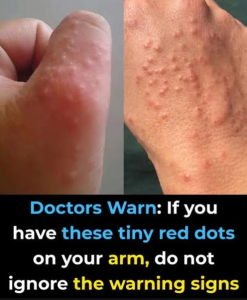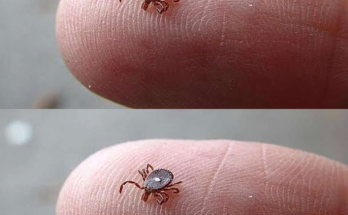Don’t Overlook These Small Red Spots on Your Arm – They Could Be Important Warning Signs
You’re getting ready for the day when you suddenly notice it — a few tiny red spots on your arm. They’re painless, not itchy, and easy to ignore. But before you brush them off as a random skin blemish or minor irritation, pause. Those seemingly harmless dots might actually be early warning signs of something your body is trying to tell you.
In many cases, red spots on the skin are harmless. However, in others, they may signal underlying health issues — some mild, others more serious. This guide breaks down why these red spots appear, what they might mean, and when you should seek medical attention.
What Are These Red Spots?
Small red dots on the skin, especially on the arms, are generally referred to as petechiae, cherry angiomas, or rashes, depending on the cause. Each type has different characteristics:
-
Petechiae are pinpoint red or purple dots caused by bleeding under the skin.
-
Cherry angiomas are bright red, slightly raised spots made up of clusters of blood vessels.
-
Rashes or allergic reactions can create flat or raised red areas, often with itching or swelling.
Let’s explore the possible causes and warning signs linked to these red marks.
1. Petechiae – A Red Flag for Internal Bleeding or Infection
What it looks like:
Tiny, flat red or purple dots that don’t fade when you press on them.
Cause:
Petechiae occur when small blood vessels called capillaries break and leak blood into the skin. They can be harmless — like from coughing too hard or after intense physical exertion — but they can also be a sign of a serious condition, including:
-
Blood disorders like leukemia or thrombocytopenia (low platelet count)
-
Infections like meningitis, sepsis, or endocarditis
-
Autoimmune diseases such as lupus
-
Side effects of medications (e.g., blood thinners or chemotherapy drugs)
When to worry:
If petechiae appear suddenly, spread quickly, or are accompanied by fever, fatigue, or easy bruising, seek immediate medical attention.
2. Cherry Angiomas – Harmless but Watch for Changes
What it looks like:
Small, bright red or dark spots, often round and slightly raised. They may appear in clusters or alone.
Cause:
Cherry angiomas are benign growths of blood vessels, and they’re common in adults over 30. The exact cause is unknown, but they may be linked to:
-
Aging
-
Genetics
-
Hormonal changes
-
Pregnancy
-
Certain toxins or chemical exposures
When to worry:
Usually, they are harmless. However, if one starts to bleed frequently, grows rapidly, or changes color or shape, it’s wise to get it checked. Rarely, changes can mimic skin cancer.
3. Keratosis Pilaris – The “Chicken Skin” Bumps
What it looks like:
Tiny red or flesh-colored bumps, often on the upper arms, thighs, or cheeks.
Cause:
Keratosis pilaris is a common and harmless skin condition caused by keratin buildup, which blocks hair follicles. It’s associated with:
-
Dry skin
-
Eczema
-
Genetics
When to worry:
It’s mostly cosmetic and not dangerous, but if it becomes inflamed or infected (red, painful, or itchy), topical treatments or dermatologist advice may help.
4. Allergic Reactions or Contact Dermatitis
What it looks like:
Red, itchy, or inflamed patches that may appear suddenly after touching or eating something.
Cause:
Exposure to allergens like:
-
Soaps, lotions, or detergents
-
Plants (e.g., poison ivy)
-
Certain foods or medications
-
Insect bites or stings
When to worry:
If red spots are accompanied by swelling, hives, difficulty breathing, or dizziness, it could be a serious allergic reaction (anaphylaxis). Seek emergency care immediately.
5. Heat Rash (Miliaria)
What it looks like:
Tiny red bumps or blisters, especially in hot, humid environments.
Cause:
Blocked sweat glands cause sweat to get trapped under the skin, resulting in irritation.
When to worry:
It’s generally harmless and resolves on its own. However, recurrent rashes or skin infections from scratching should be addressed.
6. Vasculitis – Inflammation of Blood Vessels
What it looks like:
Red or purple spots, often painful, and may be accompanied by swelling.
Cause:
Vasculitis is inflammation of the blood vessels and may result from:
-
Autoimmune conditions
-
Infections
-
Certain medications
When to worry:
If the spots are painful, spreading, and associated with fatigue, joint pain, or fever, it could be a sign of a systemic illness. Medical evaluation is crucial.
7. Blood Thinners and Bruising Disorders
What it looks like:
Red or purple spots that resemble petechiae or bruises.
Cause:
Medications like aspirin, warfarin, or certain cancer treatments can reduce clotting ability, causing spontaneous skin bleeding.
When to worry:
If you’re on medication and notice new or spreading red spots or bruises, especially with nosebleeds or bleeding gums, notify your doctor.
8. Skin Cancer or Pre-Cancerous Lesions
What it looks like:
Flat or raised red patches that persist, bleed, or change shape.
Cause:
Although most small red spots aren’t cancer, persistent, non-healing spots could indicate:
-
Basal cell carcinoma
-
Squamous cell carcinoma
-
Actinic keratosis (a pre-cancerous change)
When to worry:
If a red spot is evolving in color, shape, or size, or if it bleeds without trauma, it should be examined by a dermatologist.
When to See a Doctor
It’s not always easy to tell the difference between harmless spots and those that indicate deeper issues. Consider seeking medical advice if:
-
Spots appear suddenly or without clear cause
-
They spread quickly or grow larger
-
They’re accompanied by other symptoms (fever, fatigue, swelling, bleeding)
-
You’re on medications that affect blood clotting
-
You have a history of autoimmune disease, blood disorders, or skin cancer
How to Protect Your Skin and Stay Aware
-
Check your skin regularly: Especially arms, legs, and back.
-
Photograph unusual spots: To track changes over time.
-
Hydrate and moisturize: Dry skin is more prone to irritation and bumps.
-
Use gentle soaps and lotions: To avoid triggering reactions.
-
See a dermatologist annually: Especially if you have fair skin or a family history of skin issues.
Final Thoughts
Tiny red spots on your arm may be easy to ignore, but your skin is a powerful window into your overall health. From harmless cherry angiomas to potentially serious conditions like blood disorders or infections, these dots could carry important clues.
Trust your instincts. If something doesn’t look right — even if it’s small — get it checked. Catching a problem early could make all the difference.

